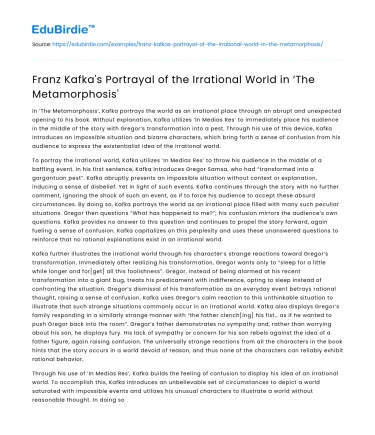In ‘The Metamorphosis’, Kafka portrays the world as an irrational place through an abrupt and unexpected opening to his book. Without explanation, Kafka utilizes ‘In Medias Res’ to immediately place his audience in the middle of the story with Gregor’s transformation into a pest. Through his use of this device, Kafka introduces an impossible situation and bizarre characters, which bring forth a sense of confusion from his audience to express the existentialist idea of the irrational world.
To portray the irrational world, Kafka utilizes ‘In Medias Res’ to throw his audience in the middle of a baffling event. In his first sentence, Kafka introduces Gregor Samsa, who had “transformed into a gargantuan pest”. Kafka abruptly presents an impossible situation without context or explanation, inducing a sense of disbelief. Yet in light of such events, Kafka continues through the story with no further comment, ignoring the shock of such an event, as if to force his audience to accept these absurd circumstances. By doing so, Kafka portrays the world as an irrational place filled with many such peculiar situations. Gregor then questions “What has happened to me?”; his confusion mirrors the audience’s own questions. Kafka provides no answer to this question and continues to propel the story forward, again fueling a sense of confusion. Kafka capitalizes on this perplexity and uses these unanswered questions to reinforce that no rational explanations exist in an irrational world.
Save your time!
We can take care of your essay
- Proper editing and formatting
- Free revision, title page, and bibliography
- Flexible prices and money-back guarantee
Kafka further illustrates the irrational world through his character’s strange reactions toward Gregor’s transformation. Immediately after realizing his transformation, Gregor wants only to “sleep for a little while longer and for[get] all this foolishness”. Gregor, instead of being alarmed at his recent transformation into a giant bug, treats his predicament with indifference, opting to sleep instead of confronting the situation. Gregor’s dismissal of his transformation as an everyday event betrays rational thought, raising a sense of confusion. Kafka uses Gregor’s calm reaction to this unthinkable situation to illustrate that such strange situations commonly occur in an irrational world. Kafka also displays Gregor’s family responding in a similarly strange manner with “the father clench[ing] his fist… as if he wanted to push Gregor back into the room”. Gregor’s father demonstrates no sympathy and, rather than worrying about his son, he displays fury. His lack of sympathy or concern for his son rebels against the idea of a father figure, again raising confusion. The universally strange reactions from all the characters in the book hints that the story occurs in a world devoid of reason, and thus none of the characters can reliably exhibit rational behavior.
Through his use of ‘In Medias Res’, Kafka builds the feeling of confusion to display his idea of an irrational world. To accomplish this, Kafka introduces an unbelievable set of circumstances to depict a world saturated with impossible events and utilizes his unusual characters to illustrate a world without reasonable thought. In doing so, Kafka firmly establishes his story within the Existentialist framework.






 Stuck on your essay?
Stuck on your essay?

